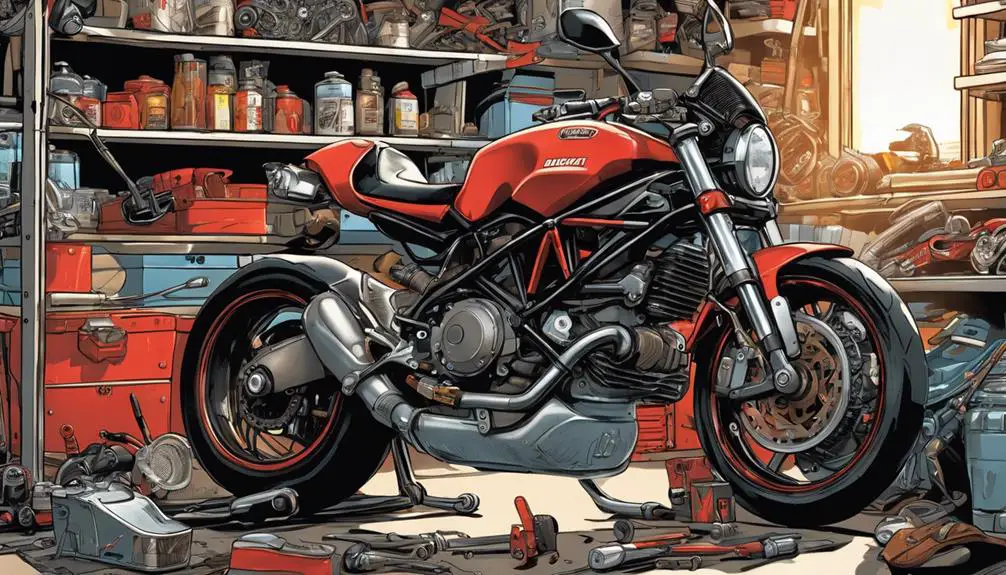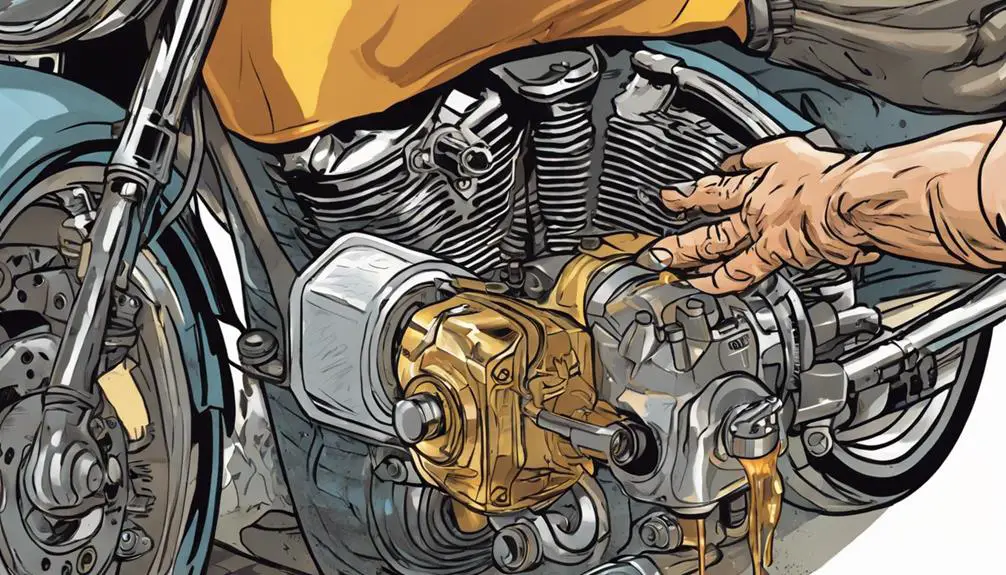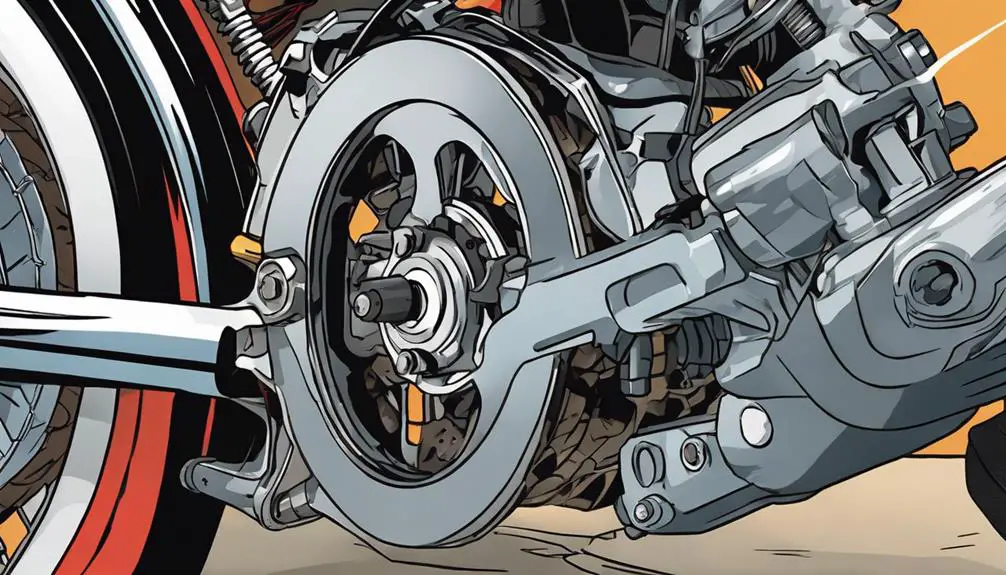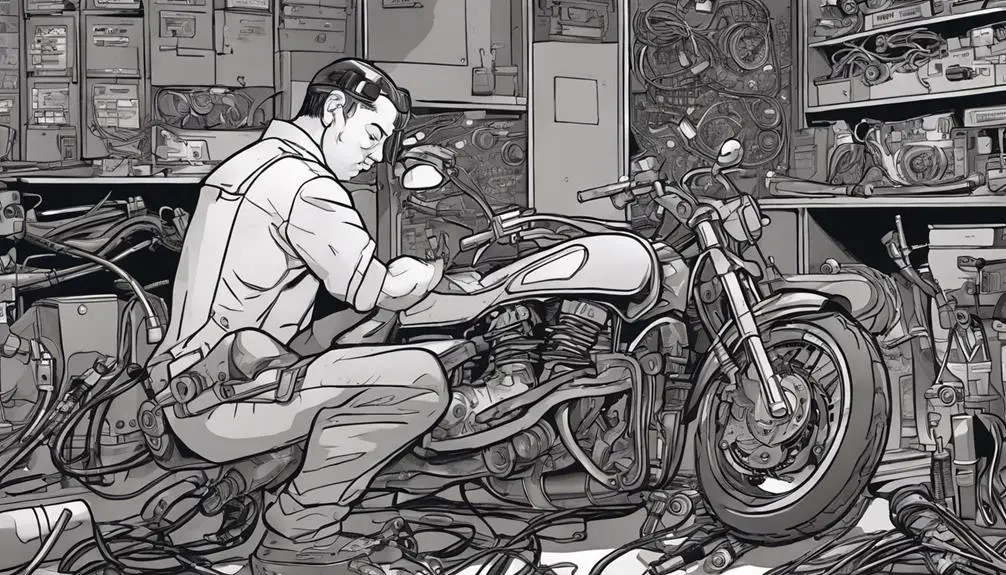Owning a motorcycle can feel exhilarating, yet neglect can lead to costly repairs. You've invested in your bike, so it makes sense to care for it properly to guarantee it lasts for years. Regular maintenance tasks, such as oil changes and tire inspections, aren't just chores—they're essential for your bike's longevity. But what specific practices should you prioritize to keep your ride in peak condition? Understanding these key maintenance strategies will not only enhance performance but also extend the life of your motorcycle.
Key Takeaways
- Perform regular oil changes every 3,000 to 5,000 miles to keep the engine running smoothly and extend its lifespan.
- Inspect and maintain tire pressure before each ride to ensure optimal handling, safety, and fuel efficiency.
- Conduct frequent brake system checks to monitor pads, fluid levels, and overall braking performance for safety.
- Maintain the chain and sprocket by ensuring proper tension, inspecting for wear, and applying lubrication as needed.
Understanding Ducati Motorcycles

When you immerse yourself in the world of Ducati motorcycles, you'll discover a blend of Italian craftsmanship and cutting-edge technology that sets them apart from the rest. Each bike resonates with a spirit of freedom, designed not just for riding but for experiencing life on two wheels. The powerful engines and sleek designs offer exhilarating performance, allowing you to carve through curves and conquer long stretches of open road.
Ducati's commitment to innovation means you're riding a machine that's engineered for both speed and agility. You'll feel the rush as you accelerate, the roar of the exhaust echoing your thirst for adventure. The unique trellis frame provides stability, enhancing your control while giving you the confidence to push the limits.
Moreover, the aesthetic appeal of a Ducati bike embodies passion and style, making every ride a statement of your individuality. Whether you're cruising through city streets or starting on a cross-country journey, Ducati motorcycles promise an exhilarating escape.
You're not just riding; you're embracing a lifestyle that celebrates liberation and the thrill of the open road. So gear up, and let the adventure begin!
Importance of Preventative Maintenance
Preventative maintenance is essential for keeping your motorcycle running smoothly and safely.
By staying on top of regular oil changes, checking tire pressure, and inspecting the brake system, you can avoid costly repairs down the road.
Just a little effort now can make a big difference in your bike's performance and longevity.
Regular Oil Changes
Regular oil changes are essential for keeping your motorcycle running smoothly and extending its lifespan.
You've got to think of your bike's engine as its heart; it needs clean oil to pump efficiently. Over time, oil gets dirty and loses its ability to lubricate, which can lead to wear and tear. Changing the oil regularly helps prevent this, ensuring your freedom on the open road isn't interrupted by mechanical failures.
You should aim to change your oil every 3,000 to 5,000 miles, but always check your owner's manual for specifics.
When you do the oil change, also replace the oil filter to catch any contaminants.
Using high-quality oil that suits your bike's engine type is vital—don't skimp on this part.
Tire Pressure Checks
Maintaining proper tire pressure is just as important as keeping your oil fresh; it directly impacts your motorcycle's handling, safety, and fuel efficiency.
When you ride, your tires are your only contact with the road. If they're under-inflated, you'll lose grip and maneuverability, making your ride riskier. On the other hand, over-inflated tires can lead to a harsh ride and uneven wear.
Checking your tire pressure takes just a few minutes, but the benefits are immense. Make it a habit to check your tires at least once a month and before long rides. Use a reliable gauge to verify you're within the manufacturer's recommended PSI. This small act of preventative maintenance can save you from costly repairs and dangerous situations down the road.
Additionally, proper tire pressure enhances fuel efficiency, allowing you to enjoy more freedom without constant stops for fuel. By taking control of your motorcycle's maintenance, you're not just prolonging its life; you're empowering your ride.
Brake System Inspections
Your motorcycle's brake system is essential for safe riding, making routine inspections crucial for preventing unexpected failures on the road.
If you want the freedom of the open highway, you need to verify your brakes are functioning perfectly. A small oversight can lead to serious consequences, so don't take chances.
Start by checking your brake fluid levels regularly. Low fluid can indicate a leak, which requires immediate attention.
Next, inspect your brake pads for wear and tear. If they're too thin, they won't provide the stopping power you need, and that can be dangerous. Pay attention to any unusual noises when you brake; squeaks or grinding sounds often signal that something's wrong.
Don't forget to examine your brake lines for any signs of damage or corrosion. A compromised line can lead to brake failure, jeopardizing your ride.
Finally, test your brakes in a safe environment to verify they respond promptly. Remember, regular brake system inspections aren't just about maintenance; they're about embracing the freedom to ride without fear.
Prioritize your safety and enjoy the liberation that comes with a well-maintained motorcycle.
Regular Oil Changes

Changing the oil in your motorcycle keeps the engine running smoothly and extends its lifespan. It's one of the most essential maintenance tasks you can perform. You don't want dirty oil circulating through your engine, causing wear and tear. Regular oil changes help maintain peak performance and guarantee your ride remains a source of freedom.
How often should you change it? Check your owner's manual, but a good rule of thumb is every 3,000 to 5,000 miles, depending on your bike and riding style. If you ride hard or in extreme conditions, consider changing it more frequently.
When you change the oil, don't forget to replace the oil filter, too. A clean filter helps keep contaminants from getting back into your engine. Make it a habit to check oil levels regularly, as well; low oil can lead to serious damage.
Tire Care and Replacement
Proper tire care is essential for ensuring safety and best performance on your motorcycle. You should regularly inspect your tires for uneven wear, cracks, or punctures.
Make it a habit to check tire pressure before every ride. Under-inflated tires can lead to poor handling and reduced fuel efficiency, while over-inflated tires can cause blowouts. Use a reliable gauge to maintain the recommended pressure listed in your owner's manual.
Additionally, rotate your tires as per the manufacturer's guidelines to promote even wear. If you notice your tread depth is getting low, it's time for a replacement. A quick way to check is by using the penny test: insert a penny into the tread with Lincoln's head facing down. If you can see the top of his head, you need new tires.
When choosing replacement tires, select ones that suit your riding style and the conditions you'll encounter. Pay attention to the type of rubber and tread pattern; these can greatly affect your ride.
Brake System Maintenance

When it comes to your motorcycle, the brake system is essential for your safety.
You should inspect the brake pads regularly and check the brake fluid levels to guarantee everything's functioning properly.
Keeping an eye on these components can make a big difference in your ride's performance.
Inspect Brake Pads Regularly
Regularly inspecting your brake pads is essential for guaranteeing your motorcycle's safety and performance. Your brakes are one of the most critical components of your ride, and worn-out pads can compromise your ability to slow down or stop when you need to. Check them at least once a month or before any long journey.
To inspect, look for signs of wear such as cracks, grooves, or a decrease in thickness. If they're less than 1/8 inch thick, it's time for a replacement. Don't just rely on feel—take a close visual look.
While you're at it, listen for any unusual sounds when you brake. Squealing or grinding can indicate that your pads are beyond their limits, and ignoring these signs can lead to more expensive repairs down the line.
Cleaning your brake pads and rotors can also help maintain peak performance. Dust and debris can affect braking efficiency, so a quick wipe-down can make a world of difference.
Taking these steps guarantees your freedom on the open road continues without interruption. A well-maintained brake system gives you the confidence to conquer every twist and turn.
Check Brake Fluid Levels
Checking your brake fluid levels is just as important as inspecting your brake pads, as low fluid can affect your braking performance considerably. If you want to ride freely and confidently, make sure your brake system is in peak condition.
Here's how to check and maintain your brake fluid:
- Locate the Reservoir: Find the brake fluid reservoir, usually near the handlebars or on the rear brake assembly. Familiarize yourself with your motorcycle's manual for specifics.
- Check Fluid Levels: Look at the markings on the reservoir. The fluid should be between the minimum and maximum lines. If it's low, it's time to top it up.
- Inspect Fluid Quality: The fluid should be clear or slightly amber. If it's dark or contaminated, it's important to replace it to guarantee peak performance.
- Use the Right Fluid: Always use the brake fluid type specified in your manual. Mixing different types can lead to brake failure.
Chain and Sprocket Inspection
Inspecting your motorcycle's chain and sprockets is essential to guarantee peak performance and prevent costly repairs down the road. A well-maintained chain and sprocket system not only enhances your riding experience but also contributes to your motorcycle's overall safety.
Start by checking the chain tension; it should neither be too loose nor too tight. A good rule of thumb is to have about an inch of vertical play.
Next, look for signs of wear on the chain and sprockets. Inspect for any kinks, rust, or excessive stretching in the chain. If you notice any of these issues, it's time to replace it. The sprockets should show uniform wear; if you see hooked teeth or significant wear patterns, they need replacing too.
Don't forget to clean and lubricate the chain regularly. This keeps it running smoothly and prolongs the life of both the chain and sprockets. Pay attention to the manufacturer's recommendations for lubrication; using the right product makes all the difference.
Electrical System Checks

To guarantee your motorcycle operates reliably, it's vital to conduct thorough electrical system checks at regular intervals. A well-maintained electrical system not only keeps your ride smooth but also enhances your freedom on the road.
Here are four key components to inspect:
- Battery Condition: Check for corrosion on terminals and verify the battery's charge is adequate. A weak battery can leave you stranded.
- Wiring and Connections: Inspect all wiring for fraying or damage. Loose connections can lead to electrical failures, impacting your bike's performance.
- Fuses: Regularly check your fuses to confirm they're intact and functioning. A blown fuse can disrupt critical systems, from lights to ignition.
- Lights and Signals: Test all lights and turn signals to make sure they're working. Proper lighting is vital for visibility and safety, keeping you free to ride without worry.
Seasonal Storage Tips
When the riding season comes to an end, it's crucial to properly store your motorcycle to keep it in top shape for your next adventure.
Start by cleaning your bike thoroughly; dirt and grime can cause corrosion over time. Once it's spotless, apply a protective wax to shield the paint and chrome.
Next, change the oil and filter. Old oil can contain contaminants that might damage your engine during its downtime. Afterward, fill up the tank and add a fuel stabilizer to prevent gumming and condensation.
Don't forget about the battery, either. Disconnect it and store it in a cool, dry place to avoid draining. If you can, use a battery tender to keep it charged.
Frequently Asked Questions
How Can I Tell if My Motorcycle Is Overheating?
You can tell if your motorcycle's overheating by watching for a few signs.
Check the temperature gauge; if it's in the red zone, you've got a problem.
Listen for unusual sounds like knocking or hissing, and look for steam or smoke rising from the engine.
If you notice a loss in power or a burning smell, it's time to pull over and let it cool down.
Don't ignore these warnings!
What Should I Do if My Motorcycle Won't Start?
When your motorcycle won't start, check the battery, check the fuel, and check the kill switch.
Make sure the battery's charged, the fuel tank's full, and the switch is on.
You can also listen for clicks or sounds; they might hint at electrical issues.
If you're still stuck, don't hesitate to seek help.
Embrace the journey ahead, and remember, every challenge is an opportunity for growth and freedom on the open road.
How Often Should I Clean My Air Filter?
You should clean your air filter every 5,000 to 10,000 miles, but it really depends on your riding conditions.
If you often ride in dusty or dirty environments, check it more frequently.
A clean air filter helps your engine breathe better, improving performance.
Don't neglect it—just like your freedom on the road, your bike deserves to run smoothly.
Trust your instincts and give it a quick inspection regularly.
What Are Signs of a Failing Battery?
Did you know that nearly 30% of motorcycle breakdowns stem from battery issues?
If your bike struggles to start or you notice dimming lights, it's time to pay attention.
Listen for unusual clicking sounds when you turn the key; that's a sign the battery's fading.
You might also spot corrosion around the terminals.
Don't let a weak battery hold you back—stay free on the road by addressing these issues promptly!
Is It Necessary to Use Premium Fuel for My Motorcycle?
You don't always need to use premium fuel for your motorcycle. Most bikes run just fine on regular unleaded, but if your owner's manual recommends premium, it's wise to follow that advice.
Premium fuel can help prevent knocking in high-performance engines, but it's not a magical solution. Trust your bike's needs, and don't let marketing dictate your choices.
Feel free to experiment, but always prioritize what keeps your ride healthy and free.
Conclusion
In the world of motorcycles, neglecting maintenance can lead to costly repairs, while regular upkeep guarantees smooth rides and longevity.
Just as a well-tuned engine purrs with power, a poorly maintained bike can sputter and stall.
By prioritizing oil changes, tire care, and brake inspections, you're not just protecting your investment; you're enhancing your riding experience.
So, embrace the routine and enjoy the thrill of the open road—your motorcycle deserves it.